
|   |

|   |
 e-mail: ukb7@rediffmail.com Looking anew at the dance scene March 10, 2020 From time to time, a seer or a visionary has looked afresh at classical dance - not quizzically or with derision - but with a vision to set fresh goals, chalk out new paths, or point out novel directions to take, collaborations to make, charters to seek. So, when a distinguished dancer and choreographer like Malavika Sarukkai sets up a trust like 'Kalavaahini' with the purpose of "fostering excellence in classical dance and the critical heritage of the land it represents", and sets up one of its objectives as "identifying and nurturing committed dancers of the next generation who differentiate themselves and work towards raising standards in dance presentation so that the Trust could aim at keeping the intrinsic flow of tradition, vibrant and salient and also give wider exposure to the participating dancers", one has to sit up and take notice. Similarly, when a performer / teacher par excellence, and a distinguished public persona like Dr. Sonal Mansingh comes for holding a four-day workshop "not only to teach about the gradations in dance, but also dwell upon the finer nuances of the art and lead the participants into her famed choreography, Sunaina, which refers to a woman's beautiful eyes, analogies of which are drawn from Odiya and Sanskrit poetry," one stands to hugely benefit from the aesthetic effort. In addition, when this is accompanied by a heart-searching by a veteran dancer like Sutapa Talukdar, "Today's generation lacks the knowledge of what makes good dance. The soul of dance seems to be missing. There is an essential difference between dance and movement. Not all movement is dance. This knowledge is lost from the consciousness of the learners. Therefore, as artists, they are flawed. It is imperative that the younger generation understand nuances of what makes a good artist. And who better to teach that than the artist who is a living, breathing example of what a true artist is!" And when the effort is buttressed by Sonal's path-breaking innovation like Natya Katha, one cannot but stand to gain a revealing insight into arts as a whole from her synoptic vision. Kalavaahini and Sparsh 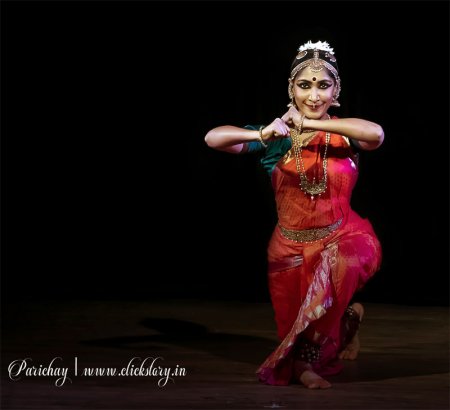 Jyotsna Jagannathan An evening of dance was presented on February 20 in Kolkata by Kalavaahini Trust in collaboration with Sparsh Studio for Performing Arts under Suman Sarawgi, using their model 'Dance series - Pursuing Excellence' that would forefront next-generation dancers to cities across India. The program featured in its third edition was Bharatanatyam by two Bangalore-based talented young dancers, Jyotsna Jagannathan and Aditya P.V. Jyotsna - groomed by A. Lakshmanaswamy, presently mentored by Malavika Sarukkai, and recipient of Bismillah Khan Yuva Puraskar - began her recital with a tryst in love with Krishna in Mallari, in raga Gambiranattai set to misra triputa tala. Its choreography was inspired by the grand procession in Thiruvananthapuram temple where Krishna's icon is taken around on a royal palanquin with much pomp and grandeur, alongside an array of musicians and dancers. Throngs of devotees gather to see this sight and young maidens are beholden to the unparalleled beauty and grace of the icon. Jyotsna revealed very good form in her presentation. The second piece was the Tamil varnam about Andal, the only female Alvar among the twelve Alvar saints of South India. As Andal grew into a beautiful young maiden, her fervor for Sri Ranganatha grew to the extent that she decided to marry only him. In the lyrics, Andal expresses her overwhelming need to become one with Ranganatha. Drenched by a deep and passionate desire, she says, "Will you not cover me with the silken compassion of your ever-flowing heart?" Written by G Vijayaraghavan and music composed by K. Hari Prasad, Jyotsna did ample justice to the theme. Jyotsna's third item was the perennial favorite Krishna nee begane baro... Emitting the vatsalya rasa by Yashoda for the sterling prankster Krishna - in a thousand and one variations, and yet never tiring - was attempted quite eloquently to the enjoyment of the audience. She concluded with a Thillana in raga Dhanasri and adi tala. Composed by Swati Thirunal, the lyrics described Gopis enjoying their time away from mundane chores, showering their affection on the little Krishna and reveling in his unparalleled beauty, charm and mysticism. Jyotsna was accompanied by Deepu Nair on vocal, Prasanna on nattuvangam, Harsha Samaga on mridangam, and Mahesh Swamy on flute. 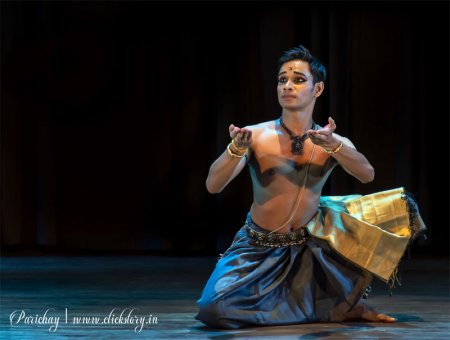 Aditya P.V. Aditya P.V - trained under guru Latha Edavalath, then under the dance-duo, the Kirans, and currently under Guru Sudharani Raghupathy - immediately impressed with his chiseled body and intent look and demeanor. He began with Ripples, drawing from Nasadiya Sukta of the Rig Veda, in raga Malayamarutam and adi tala. Focusing on the cosmic potential of water and marked by serenity and peace, Aditya drew on the concept of 'All is Water' as omnipresent: from the human body to the vast ocean, from the nectar to light. Asserting that water is the base of everything, he also drew a comparison between dance and water: fluid, mystical, luminous, chaotic and calm, all at once. In the second piece Samyoga, Aditya drew from Krishna Ashtakam of Adi Shankara, set to ragamalika. He skillfully continued to dwell upon the theme of water donning the role of Ksheerasagara: How lucky am I to put you to sleep on Adishesha...When you took the form of Krishna, I followed you to Gokula as Yamuna...When you were a child, I yearned to touch your lotus feet, the rain that poured touched your feet and united with me... How lucky am I to get the first abhisheka from your feet...As a young man, you protected me from the poison of Kalinga...The relation that Yamuna shared with you went beyond the cycle of life and death, beyond the notion of physical and spiritual, beyond time and space... In the concluding piece, Aditya retained his metaphor of water, now as Ganga: Gange maam paahi..., a Dikshitar kriti set in raga Chenchuruti and khanda eka tala. It ran thus: We are born to one mother and ultimately uniting as ashes with another mother...The one who nourishes nurtures and sustains life... Aditya was intelligent in choosing a consistent theme throughout and brilliant in execution, justifying his selection. Aditya was accompanied by Rohit Bhat on vocal, Parshwanath Upadhye on nattuvangam, Harsha Samaga on mridangam, Mahesh Swamy on flute, and Kaustav Majumder on sitar. South Gurukul Society An evening of Odissi dance was presented on February 24 by the South Gurukul Society in cooperation with Kolkata's corporate world, where the senior students of its accomplished director Sutapa Talukdar, set out reverently to show their appreciation to guru Sonal Mansingh. 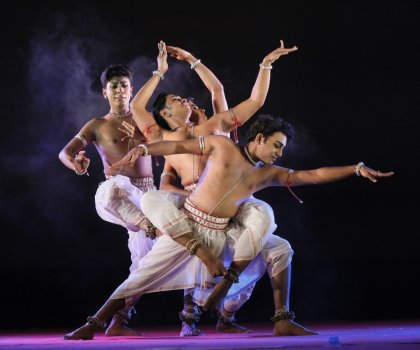
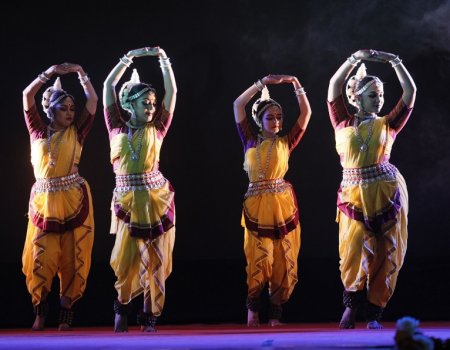
Four male dancers set out first with a Saraswati Vandana using the graphic ode to the goddess of learning, Ya kunnendu tushara hara dhabala... As a Mangalacharan set to ragamalika, this was both a manifestation of the benediction for universal enlightenment and an enigma whose fragrance enhances the spirit of all around. Four female dancers came up next with an Oriya abhinaya Dekhiba para asare... This traditional song described four gopis being enraptured and overwhelmed by the roop, rasa and prana of their beloved pastoral god. Their final item was a scintillating Pallavi set in raga Simhendra Madhyamam. Executed by seven male and female dancers, this was an intricate pure dance set in complex tala and laya. In choreographic freshness and aesthetic excellence, the gradual unfolding of nritta in angikabhinaya stood out to be the best piece in this first part of the program. 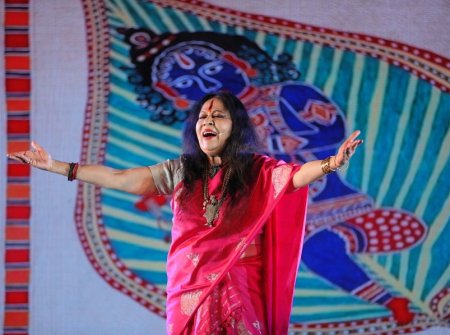 Sonal Mansingh Natya Katha presented by Dr. Sonal Mansingh in a uniquely conceived style, was the piece de resistance of the later part of the evening. The legendary icon that Sonal already is, came back to the viewers with undiminished energy in a new avatar of dramatic story-teller. Her act comprised acting, dancing, singing, reciting and simple miming. With a polyphonic script - illumined on the cyclorama by the most eloquent magnification of miniature paintings of India in telling colors - the gripping content unfolded audio visually to the spectators, taking them from Krishna's birth right up to his settling down in Dwarka handling urgent political affairs. Punctuated by live music (comprising pakhawaj, flute and keyboard by three very competent musicians), the composite narrative rendered with asymmetric hastamudras, eloquent vachikabhinaya, and her ever ethereal sattvik enlivened the colorful Bhagavat Purana Hari Vamsha and other parables in multiple lingo. The singing persona of Sonal, not so much in evidence in earlier years, was a delightful bonus for the eastern metropolitan audience, which ranged from Maiya mori, mai nahi makhan khayo... up to the final Meera Bhajan Chakar rakho ji..., not excluding the most poignant entreaty by the bereaved Gopis -- asking for their very personal Shyam back - conveyed to his bemused messengers from Dwarka preoccupied with his good tidings. In a masterly script, Sonal's multiple-illustrated emphasis on the killing of demons, Kaliyadaman encounter, playfully courting Radha at Barsana, and particularly Sudama's sumptuous feastings at Dwarka and the subsequent surprise that awaited him back home were most riveting. Delightful musical support was provided by Rishishankar Upadhyaya on pakhwaj, Prabhat Dangi on chords and Pankaj Mishra on flute. No doubt, a superlative show, justifying the long standing ovation at the end!  Dr. Utpal K Banerjee is a scholar-commentator on performing arts over last four decades. He has authored 23 books on Indian art and culture, and 10 on Tagore studies. He served IGNCA as National Project Director, was a Tagore Research Scholar and is recipient of Padma Shri. Post your comments Please provide your name and email id when you use the Anonymous profile in the blog to post a comment. All appropriate comments posted with name and email id in the blog will also be featured in the site. |